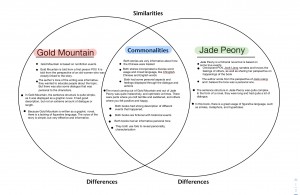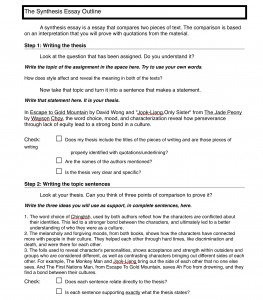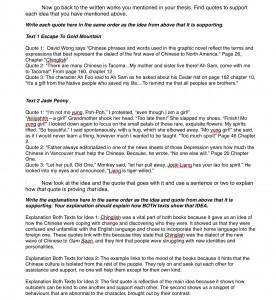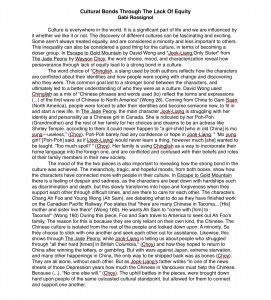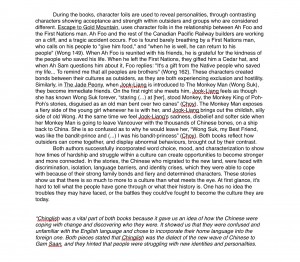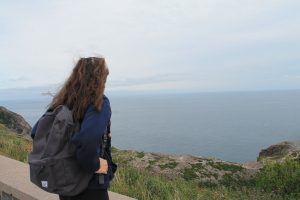Wow, so I’m back for the first time since June. And guess what we started the new school year with? Essay writing…Yay? Since the beginning of the year, we have been practicing writing many different styles of essays, for our upcoming English Provincial Exam. And I’ve decided that the most difficult and complicated type by far was evidently the Synthesis essay. There are a lot of stages of preparation that go towards actually writing the essay. In our case, we read the material we would be comparing, then made a venn diagram, pulled together an essay outline, and finally wrote the actual piece.
We began our process earlier in the year when we read Escape To Gold Mountain, by David Wong. Then we read “Jook-Liang: Only Sister” from The Jade Peony by Wayson Choy. But, at the time, we were unaware that we would be comparing the two in a very interestingly formed essay.
In class, Ms Willemse introduced the idea of “the synthesis essay” to us, and I’m not sure about everyone else, but I know that I began to freak out. I didn’t even know what synthesizing meant, let alone how I was going to write an essay about it! But as we got familiarized with the meaning and idea of a synthesis piece, I was less panicked. The topic was “how style reveals the meaning of the two books”, and I would soon find out what this strange sentence entailed. The first step I took, was creating a venn diagram that compared the styles of The Jade Peony and Escape To Gold Mountain. After I had completed it, the similarities and differences were clear and organized. The concept of style in a piece of writing also became clear to me, and it made my essay ideas begin to flow.
The second part of the preparation for my essay, was my outline. At first, I had a clear path of what I was going to include in my essay, and what ideas I would touch on in the piece. I had to plan and come up with a hook, thesis, my body paragraphs, and a strong conclusion. I started off great, with my thesis and topics being very strong and informative. Then as I progressed with adding quotes and explanations of my paragraphs, things became a little rocky and I was confused about how to pick my quotes wisely and use them as evidence to support my ideas. I worked through my troubles and got it finished, but I knew that there needed to be changes made in my final draft.
Now for the most important part, the actual writing. It can’t be that hard, right?… Wrong! I found this stage to be the most challenging, as I had to mush all of my ideas and quotes into a well structured and flowing essay. One would’ve thought that this would be the simplest step, as I had an outline to look back and refer to. But mine needed lots of reviewing and revising, which takes time, which I just didn’t have! So instead, I took my ideas from my outline, put them in sequence, and added, changed, edited, and deleted. Later on I began to see the paragraphs and my ideas form and flow.
In the end, after many struggles, confusions, and brain farts, I finally had a product that somewhat resembled a synthesis essay. Don’t get me wrong, I am very proud of what I came out with, I think my essay was well structured, and my ideas were solid. But there are always things to work on and improve. In this case, I think I could have put in more transitions, and maybe done a better job at linking my topics and main ideas together. I also learned so many useful writing skills during our process that I will carry with me into my future. One very important thing that I learned from writing this essay was inserting quotations… Shout out to Ms. Willemse for repeatedly and painfully explaining multiple times. I also realized how style is able to reveal meaning, but I think you have to write your own synthesis essay to find it out for yourself. (Or you could just read mine).
